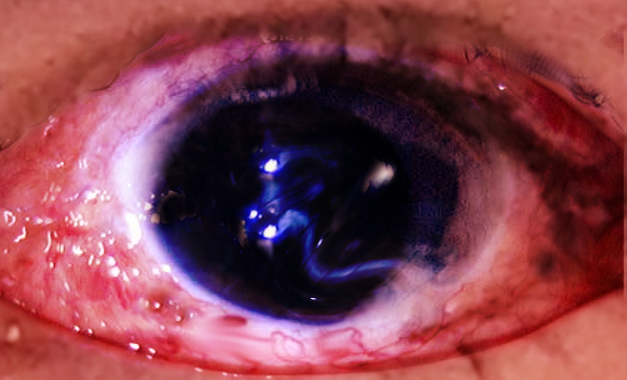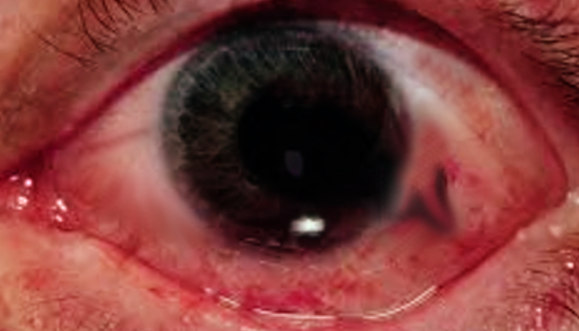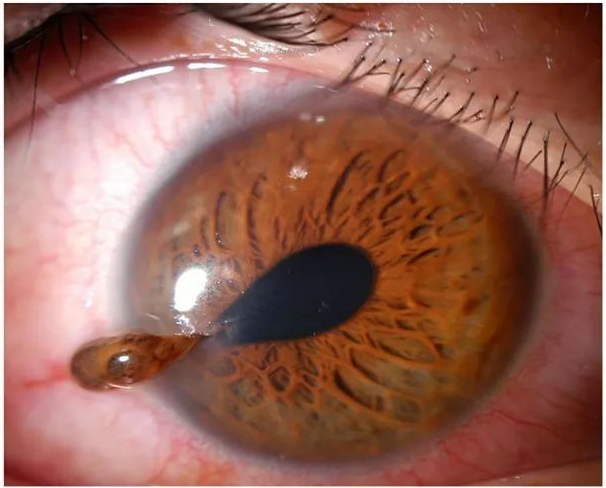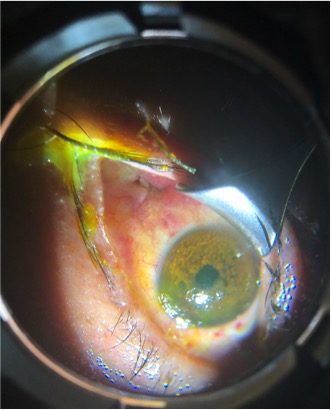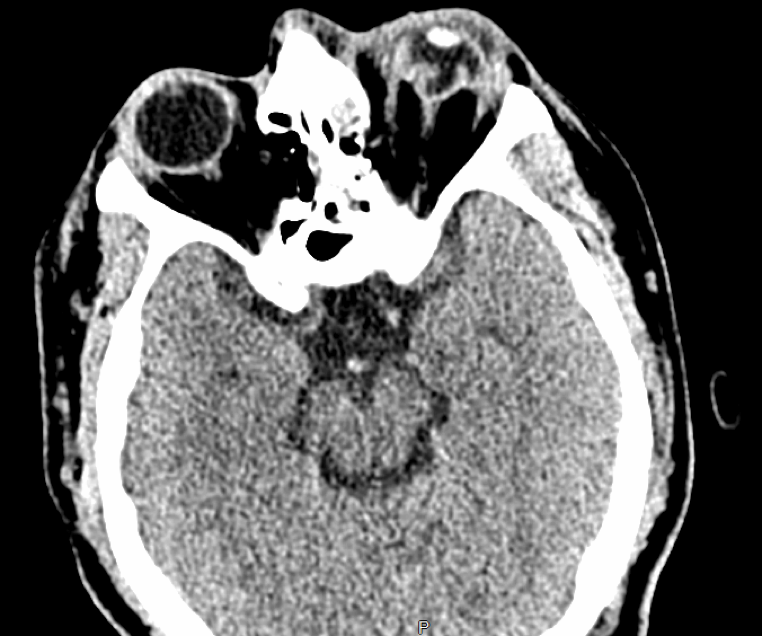[1]
Li X,Zarbin MA,Bhagat N, Pediatric open globe injury: A review of the literature. Journal of emergencies, trauma, and shock. 2015 Oct-Dec;
[PubMed PMID: 26604528]
[2]
Thompson CG,Kumar N,Billson FA,Martin F, The aetiology of perforating ocular injuries in children. The British journal of ophthalmology. 2002 Aug;
[PubMed PMID: 12140216]
[3]
Hughes E,Fahy G, A 24-month review of globe rupture in a tertiary referral hospital. Irish journal of medical science. 2019 Sep 13;
[PubMed PMID: 31520281]
[5]
Li L,Lu H,Ma K,Li YY,Wang HY,Liu NP, Etiologic Causes and Epidemiological Characteristics of Patients with Intraocular Foreign Bodies: Retrospective Analysis of 1340 Cases over Ten Years. Journal of ophthalmology. 2018;
[PubMed PMID: 29651344]
Level 2 (mid-level) evidence
[6]
Ben Simon GJ,Moisseiev J,Rosen N,Alhalel A, Gunshot wound to the eye and orbit: a descriptive case series and literature review. The Journal of trauma. 2011 Sep
[PubMed PMID: 21909007]
Level 2 (mid-level) evidence
[8]
Born CT, Blast trauma: the fourth weapon of mass destruction. Scandinavian journal of surgery : SJS : official organ for the Finnish Surgical Society and the Scandinavian Surgical Society. 2005
[PubMed PMID: 16425623]
[9]
Koo L,Kapadia MK,Singh RP,Sheridan R,Hatton MP, Gender differences in etiology and outcome of open globe injuries. The Journal of trauma. 2005 Jul;
[PubMed PMID: 16096559]
[10]
Kumar K,Figurasin R,Kumar S,Waseem M, An Uncommon Meridional Globe Rupture due to Blunt Eye Trauma. Case reports in emergency medicine. 2018;
[PubMed PMID: 30319823]
Level 3 (low-level) evidence
[11]
Wong TY,Klein BE,Klein R, The prevalence and 5-year incidence of ocular trauma. The Beaver Dam Eye Study. Ophthalmology. 2000 Dec;
[PubMed PMID: 11097595]
[12]
Bisplinghoff JA,McNally C,Duma SM, High-rate internal pressurization of human eyes to predict globe rupture. Archives of ophthalmology (Chicago, Ill. : 1960). 2009 Apr
[PubMed PMID: 19365034]
[14]
Couperus K,Zabel A,Oguntoye MO, Open Globe: Corneal Laceration Injury with Negative Seidel Sign. Clinical practice and cases in emergency medicine. 2018 Aug;
[PubMed PMID: 30083651]
Level 3 (low-level) evidence
[15]
Yuan WH,Hsu HC,Cheng HC,Guo WY,Teng MM,Chen SJ,Lin TC, CT of globe rupture: analysis and frequency of findings. AJR. American journal of roentgenology. 2014 May;
[PubMed PMID: 24758666]
[16]
Chou C,Lou YT,Hanna E,Huang SH,Lee SS,Lai HT,Chang KP,Wang HM,Chen CW, Diagnostic performance of isolated orbital CT scan for assessment of globe rupture in acute blunt facial trauma. Injury. 2016 May;
[PubMed PMID: 26944178]
[17]
Modjtahedi BS,Rong A,Bobinski M,McGahan J,Morse LS, Imaging characteristics of intraocular foreign bodies: a comparative study of plain film X-ray, computed tomography, ultrasound, and magnetic resonance imaging. Retina (Philadelphia, Pa.). 2015 Jan
[PubMed PMID: 25090044]
Level 2 (mid-level) evidence
[18]
Ritson JE,Welch J, The management of open globe eye injuries: a discussion of the classification, diagnosis and management of open globe eye injuries. Journal of the Royal Naval Medical Service. 2013;
[PubMed PMID: 24511795]
[20]
Iyer MN,Kranias G,Daun ME, Post-traumatic endophthalmitis involving Clostridium tetani and Bacillus spp. American journal of ophthalmology. 2001 Jul;
[PubMed PMID: 11438069]
[21]
Lorch A,Sobrin L, Prophylactic antibiotics in posttraumatic infectious endophthalmitis. International ophthalmology clinics. 2013 Fall;
[PubMed PMID: 24088943]
[22]
Bower T,Samek DA,Mohammed A,Mohammed A,Kasner P,Camoriano D,Kasner O, Systemic medication usage in glaucoma patients. Canadian journal of ophthalmology. Journal canadien d'ophtalmologie. 2018 Jun;
[PubMed PMID: 29784160]
[23]
Agrawal R,Rao G,Naigaonkar R,Ou X,Desai S, Prognostic factors for vision outcome after surgical repair of open globe injuries. Indian journal of ophthalmology. 2011 Nov-Dec;
[PubMed PMID: 22011491]
[24]
Zhang Y,Zhang MN,Jiang CH,Yao Y,Zhang K, Endophthalmitis following open globe injury. The British journal of ophthalmology. 2010 Jan;
[PubMed PMID: 19692359]
[25]
Thevi T,Abas AL, Role of intravitreal/intracameral antibiotics to prevent traumatic endophthalmitis - Meta-analysis. Indian journal of ophthalmology. 2017 Oct;
[PubMed PMID: 29044054]
Level 1 (high-level) evidence
[26]
Narang S,Gupta V,Gupta A,Dogra MR,Pandav SS,Das S, Role of prophylactic intravitreal antibiotics in open globe injuries. Indian journal of ophthalmology. 2003 Mar;
[PubMed PMID: 12701861]
[27]
Yeh S,Colyer MH,Weichel ED, Current trends in the management of intraocular foreign bodies. Current opinion in ophthalmology. 2008 May;
[PubMed PMID: 18408498]
Level 3 (low-level) evidence
[28]
Loporchio D,Mukkamala L,Gorukanti K,Zarbin M,Langer P,Bhagat N, Intraocular foreign bodies: A review. Survey of ophthalmology. 2016 Sep-Oct;
[PubMed PMID: 26994871]
Level 3 (low-level) evidence
[29]
Jindal A,Pathengay A,Mithal K,Jalali S,Mathai A,Pappuru RR,Narayanan R,Chhablani J,Motukupally SR,Sharma S,Das T,Flynn HW Jr, Endophthalmitis after open globe injuries: changes in microbiological spectrum and isolate susceptibility patterns over 14 years. Journal of ophthalmic inflammation and infection. 2014 Feb 18
[PubMed PMID: 24548669]
[30]
Ahmed Y,Schimel AM,Pathengay A,Colyer MH,Flynn HW Jr, Endophthalmitis following open-globe injuries. Eye (London, England). 2012 Feb;
[PubMed PMID: 22134598]
[31]
Singh S,Sharma B,Kumar K,Dubey A,Ahirwar K, Epidemiology, clinical profile and factors, predicting final visual outcome of pediatric ocular trauma in a tertiary eye care center of Central India. Indian journal of ophthalmology. 2017 Nov;
[PubMed PMID: 29133650]
[32]
Yalcin Tök O,Tok L,Eraslan E,Ozkaya D,Ornek F,Bardak Y, Prognostic factors influencing final visual acuity in open globe injuries. The Journal of trauma. 2011 Dec;
[PubMed PMID: 22182891]
[33]
Meng Y,Yan H, Prognostic Factors for Open Globe Injuries and Correlation of Ocular Trauma Score in Tianjin, China. Journal of ophthalmology. 2015;
[PubMed PMID: 26491549]
[34]
Agrawal R,Wei HS,Teoh S, Prognostic factors for open globe injuries and correlation of ocular trauma score at a tertiary referral eye care centre in Singapore. Indian journal of ophthalmology. 2013 Sep;
[PubMed PMID: 24104709]
[35]
Lieb DF,Scott IU,Flynn HW Jr,Miller D,Feuer WJ, Open globe injuries with positive intraocular cultures: factors influencing final visual acuity outcomes. Ophthalmology. 2003 Aug;
[PubMed PMID: 12917173]
[36]
Kuhn F,Maisiak R,Mann L,Mester V,Morris R,Witherspoon CD, The Ocular Trauma Score (OTS). Ophthalmology clinics of North America. 2002 Jun
[PubMed PMID: 12229231]
[37]
Venkatesh R,Bavaharan B,Yadav NK, Predictors for choroidal neovascular membrane formation and visual outcome following blunt ocular trauma. Therapeutic advances in ophthalmology. 2019 Jan-Dec
[PubMed PMID: 31206099]
Level 3 (low-level) evidence
[38]
Soylu M,Sizmaz S,Cayli S, Eye injury (ocular trauma) in southern Turkey: epidemiology, ocular survival, and visual outcome. International ophthalmology. 2010 Apr;
[PubMed PMID: 19190858]
[39]
Gürdal C,Erdener U,Irkeç M,Orhan M, Incidence of sympathetic ophthalmia after penetrating eye injury and choice of treatment. Ocular immunology and inflammation. 2002 Sep;
[PubMed PMID: 12789598]
[40]
He X,Hahn P,Iacovelli J,Wong R,King C,Bhisitkul R,Massaro-Giordano M,Dunaief JL, Iron homeostasis and toxicity in retinal degeneration. Progress in retinal and eye research. 2007 Nov;
[PubMed PMID: 17921041]
[41]
Magauran B, Conditions requiring emergency ophthalmologic consultation. Emergency medicine clinics of North America. 2008 Feb;
[PubMed PMID: 18249265]
[42]
Coles WH,Haik GM, Vitrectomy in intraocular trauma. Its rationale and its indications and limitations. Archives of ophthalmology (Chicago, Ill. : 1960). 1972 Jun;
[PubMed PMID: 5032732]
[43]
Elder MJ,Stack RR, Globe rupture following penetrating keratoplasty: how often, why, and what can we do to prevent it? Cornea. 2004 Nov;
[PubMed PMID: 15502477]
[44]
Kawashima M,Kawakita T,Shimmura S,Tsubota K,Shimazaki J, Characteristics of traumatic globe rupture after keratoplasty. Ophthalmology. 2009 Nov;
[PubMed PMID: 19766315]
[45]
Li X,Zarbin MA,Langer PD,Bhagat N, POSTTRAUMATIC ENDOPHTHALMITIS: An 18-Year Case Series. Retina (Philadelphia, Pa.). 2018 Jan;
[PubMed PMID: 28590965]
Level 2 (mid-level) evidence

